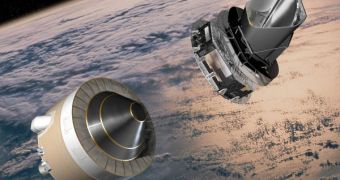Yesterday, aeronautics company Arianespace managed to launch its 40th successful mission to orbit, safely carrying the Herschel and Planck space telescopes to their intermediary destination aboard an Ariane 5 delivery system. The picture-perfect launch, which took place at 6:12 am Pacific Time (9:12 am EDT / 1312 GMT) at the Korou Space Center, in the French Guyana, South America, was only the first step in the wonderful journey that the observatories had ahead of them.
The launch was also the only common point of the two satellites, which have now engaged in different flight paths, and will scout totally different aspects of the Universe. While Herschel will arrive at its destination shortly, Planck will reach the L2 orbital point in about two to three months, and will begin its observations roughly at that time. The craft are also designed to position themselves at various locations around the second Lagrangian point, more than 1.5 million kilometers away from the Earth.
“These two missions have spent a lot of time together. But now they are going their separate ways, each ready to do what it does best,” NASA Project Manager for both Herschel and Planck, Ulf Israelsson, said. The expert works out of the Jet Propulsion Laboratory (JPL), in Pasadena, California. Despite the fact that the observatories belong to the European Space Agency (ESA), the American agency has also played an important part in the ten-year development of the ambitious project.
Herschel, which is officially called the Far Infrared and Sub-millimeter Telescope (FIRST), will feature the largest mirror deployed thus far in space. The 3.5-meter behemoth will collect and interpret long-wavelength radiation from some of the coldest and most distant objects in the early Universe. The 7.5-meter-high observatory is in charge with determining exactly how the Cosmos looked like as little as 350,000 years after it was exploded into existence. Herschel will also carry the most powerful infrared equipment in history, and experts have huge expectations of it.
On the other hand, the smaller Planck telescope, which was the second to launch from the delivery vehicle, was originally called COBRA/SAMBA (Cosmic Background Radiation Anisotropy Satellite / Satellite for Measurement of Background Anisotropies). It has an equally difficult mission, in that its objective is to survey the Cosmic Microwave Background (CMB). This type of radiations can only be detected with radio observers, but it can yield significant knowledge of how the Universe itself came to be, as well as of why it looks like it currently does. In addition, experts are hopeful that data supplied by Planck will help with testing the existing theories on the formation of the Cosmos, as well as on its expansion.

 14 DAY TRIAL //
14 DAY TRIAL //